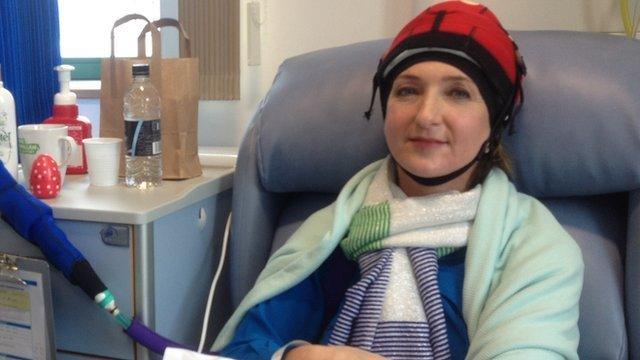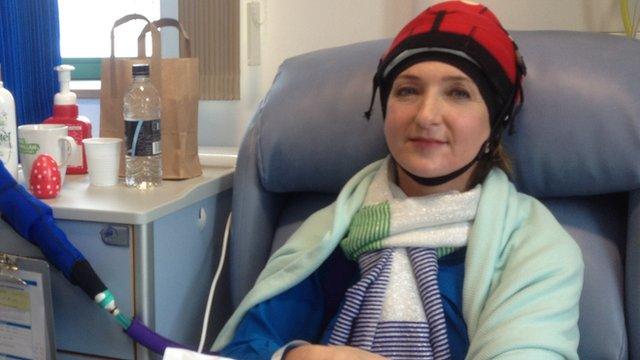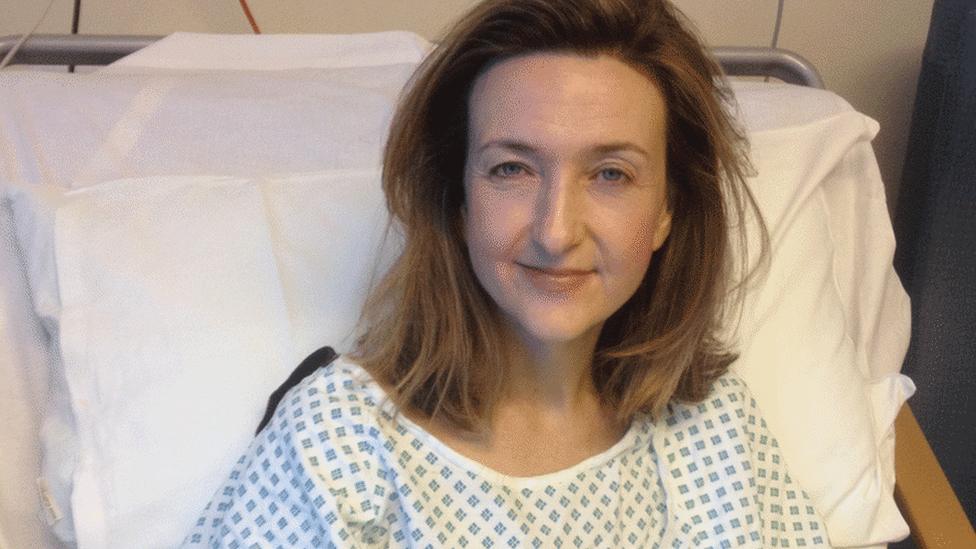Victoria Derbyshire breast cancer diary part three: Hair loss
- Published
Victoria Derbyshire has decided to reveal the hair loss caused by her chemotherapy treatment
BBC journalist Victoria Derbyshire has started losing her hair as a side-effect of chemotherapy treatment for breast cancer. She has decided to reveal she is now wearing a wig.
Derbyshire has been producing diaries since she was diagnosed with breast cancer at the end of July, to try to help demystify the treatment. Her third one was recorded across November and December.
Speaking on 1 December, she explains: "It's now six days since the second chemotherapy session and I'm at the stage where I'm feeling a little dispirited.
"One of the things that I'm finding difficult to come to terms with is losing my hair. I would say I have lost about 30-50% of it."
Derbyshire pauses, before taking off her wig to reveal a depleted head of hair, cut above the shoulders.
It is the first time the journalist has made this public. She takes a deep breath, and - with her voice breaking up - says in a quiet tone: "I am finding this hard."
'Disconcerting'
The potential hair loss, along with other side-effects of chemotherapy, was first discussed with her by an oncologist before her treatment began.
Different forms of chemotherapy result in varying levels of hair loss. Some do not cause any loss at all, or only slight thinning.
She was warned, however, that the adjuvant chemotherapy she would be having - designed to help stop cancer coming back or spreading to other parts of the body - usually leads to the loss of "all the hair on your head".

Derbyshire's hair loss began two to three weeks after her first chemotherapy session
For Derbyshire, this started two-and-a-half weeks after the first cycle of chemotherapy - a clump of hair falling out in the process of getting ready to go to a friend's 40th birthday party.
"I was prepared for it - obviously it's a side-effect of chemotherapy - but it's slightly disconcerting nevertheless," she explains in the diary, holding the hair to the camera.
She had worn a cold cap during her first chemotherapy session. Tightly fitted and so cold it forms ice inside, it was designed to minimise hair loss. She wore a newer, more advanced model in the second and third sessions - although the hair loss continued to a much lesser extent.

Find out more
Watch the full version of Victoria Derbyshire's breast cancer diary online.

In the eight days that followed the second cycle, however - in which she "bounced back" and recovered from the treatment - she began to adjust to the hair loss.
"I have got used to wearing a wig, which is something I never thought I'd be able to say," she explains on Christmas Eve.
"The idea a few weeks ago of wearing a wig absolutely horrified me. It represented stress, it represented something peculiar and not me. Now, I can put it on in five minutes in the morning."

Derbyshire has been presenting her BBC Two programme wearing a wig over the past month
It is this practical aspect that has helped her come to terms with the hairpiece.
Between Christmas and New Year's Day, she adds: "We went to a friend's Christmas party the other day and when we got back my youngest son whispered to me and said 'mummy, no-one would have known you were wearing a wig'.
"Maybe they did know and they were just too polite to say anything, but the point is it lets me crack on and get on with things - which is absolutely great."

Cancer and hair loss
The effect of cancer drugs can range from mild thinning of the hair, partial or complete hair loss. Some do not cause any hair loss at all, including certain chemotherapy drugs.
Hair loss can be affected by the dose of drugs taken and an individual's sensitivity to them.
Patients are advised to plan for potential hair loss, including whether they might wish to wear a wig, before treatment begins.
If hair does fall out, it usually begins two to three weeks after treatment starts and takes place gradually.
After chemotherapy, hair may take several months to grow back and is likely to be softer. It may come back a different colour and may be more curly than before. It is very rare for hair not to grow back at all.
Source: Cancer Research UK, external

Over the past month Derbyshire has presented her BBC Two programme while wearing a wig, but has not drawn attention to it.
Now, she now feels the time is right to be open both with colleagues and in public.
"When I started wearing a wig a few weeks ago I didn't tell anyone at work I was wearing one, because I needed a little time to adjust to it myself. I can confirm I'm now fully adjusted to it and so feel comfortable in being totally open about it," she says, smiling.
"But we are a close-knit team at work and they are a bunch of journalists so I'm guessing they've sussed it already," she jokes. "If they haven't, I'll be a bit disappointed to be honest."

Derbyshire has been wearing a cold cap during treatment to minimise hair loss
Derbyshire, however, is keen not to downplay the emotional toll of losing her hair.
"It has been the thing that has affected me the most, more than a mastectomy," she says, having undergone surgery in September 2015.
The presenter has three chemotherapy sessions and a series of radiotherapy sessions remaining before her treatment concludes in the spring. She expects more hair loss to occur and has started to lose parts of her eyebrows.
Hair loss, however, is almost always temporary, with hair growing back after treatment ends.
Derbyshire is certainly keeping this positive thought at the front of her mind. "Roll on 2016," she says.
The Victoria Derbyshire programme is broadcast on weekdays between 09:15 and 11:00 on BBC Two and the BBC News channel.
- Published11 November 2015

- Published12 October 2015
